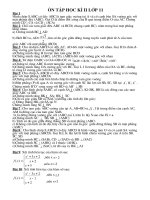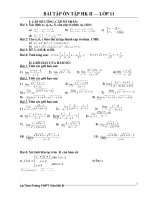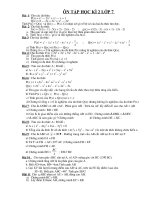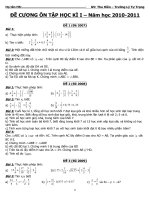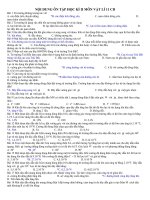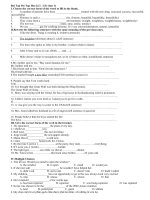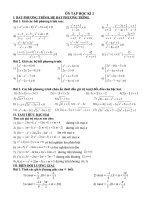Cac tiet on tap hoc ki 2 lop 11
Bạn đang xem bản rút gọn của tài liệu. Xem và tải ngay bản đầy đủ của tài liệu tại đây (153.79 KB, 7 trang )
Lesson plan Bùi Thị Biền Yên Thuỷ A High school
Distributive period: 101 Date of signing:
Date of preparation: Date of teaching:
REVIEW (1
ST
period)
1. Aims:
- To practice speaking, reading, listening and writing.
- To make Ss feel confident of their ability in order to understand and speak English by setting tasks
within their competence.
- To help Ss have the opportunities to develop their oral fluency.
- To introduce some words and phrases.
2. Language focuses:
- Defining relative clauses & non defining relative clauses.
- Relative pronouns with prepositions.
3. Teaching aids:
- Textbook, board, pictures.
4. Procedure:
Time/Stages Activities Interactions
1. Warm-up
6 minutes
2. New lesson
37 minutes
- Greeting and checking attendance.
- Teacher asks Ss to do the homework.
I. Grammar:
1. Defining relative clauses & non defining relative clauses.
1.1. definite Relative clauses.
a. Form :
- Mệnh đề quan hệ xác định không đợc ngăn cách với mệnh đề chính bởi
dấu phẩy nào.
b. structure :
- Tiền ngữ của mệnh đề quan hệ xác định là từ cha xác định thờng là
danh từ chung vì thế mệnh đề quan hệ không thể lợc bỏ .
Eg : This is a man who is living in Hanoi.
1.2 . Non definite relative clauses.
a. Form :
Mệnh đề quan hệ không xác định đợc ngăn cách với mệnh đề chính
bởi những dấu phẩy.
b. structure :
- Tiền ngữ của mệnh đề quan hệ không xác định là từ xác định thờng là
danh từ riêng , danh từ đợc bổ nghĩa bởi các tính từ chỉ định và tính từ sở
hữu . vì thế mệnh đề quan hệ có thể lợc bỏ .
Eg : The Mekong River , which starts in Tibet, is the longest river in
Indonesia.
Note: That không đợc sử dụng ở mệnh đề quan hệ không xác định.
2.Relative pronouns with preposition:
- Trong Tiếng Anh thờng chỉ có đại từ quan hệ whom và which
có giới từ đi kèm.
Note: Ta chỉ chuyển giới từ lên trớc các đại từ này khi không làm thay
đổi nghĩa của động từ.
Eg : This is a man to whom I often talk .
Không dùng : This is a man after whom I often look .
Question 1: Combine the sentences using relative pronouns.
1. The taxi driver was friendly. He took me to the airport.
2. I liked the woman. I met her at the party last night.
T < > Ss
T < > Ss
Pair work
Ss < > Ss
T < > Ss
1
Lesson plan Bùi Thị Biền Yên Thuỷ A High school
3. Homework:
2 minutes
3. I must thank the people. I got a present from them.
4. The man called the police. His wallet was stolen.
5. The city is beautiful. We spent our holiday in that city.
6. She knows somebody. That person can sing very well.
7. This is the house. My father like the garden of the house.
8. The teacher punished the student. This student was naughty.
9. She fell in love with a man. The man was from another country.
10. I like to write to friends. These friends are living far away from me.
II. Consolidation:
- T gives comments
- Teacher asks Ss to give examples for the grammatical parts above.
T < > Ss
D. Self study:
E. To instruct Ss to do the homework.
Distributive period: 102 Date of signing:
Date of preparation: Date of teaching:
REVIEW (2
nd
period)
1. Aims:
- To practice speaking, reading, listening and writing.
- To make Ss feel confident of their ability in order to understand and speak English by setting tasks
within their competence.
- To help Ss have the opportunities to develop their oral fluency.
- To introduce some words and phrases.
2. Language focuses:
- Relative clauses replaced by participles and to infinitives.
3. Teaching aids:
- Textbook, board, chalks.
4. Procedure:
Time/Stages Activities Interactions
1. Warm-up
6 minutes
2. New
lesson
- Greeting and checking attendance.
- Teacher asks Ss to do the homework.
I. Grammar: (Continue)
- Note: chỉ dùng khi đại từ quan hệ làm chủ từ và khi hai
T < > Ss
T < > Ss
2
Lesson plan Bùi Thị Biền Yên Thuỷ A High school
37 minutes
3. Homework:
2 minutes
mệnh đề cùng thời gian hoặc thời gian đợc hiểu rõ / xác
định.
1. Relative clauses replaced by participles.
- Chỉ dùng khi đại từ quan hệ làm chủ từ và khi hai mệnh đề cùng thời
gian hoặc thời gian đợc hiểu rõ / xác định.
A. Present participles: Khi động từ của mệnh đề quan hệ đợc chia ở thể
chủ động ta dùng hiện tại phân từ để thay thế cho đai từ quan hệ.
Eg : The man who is sitting next to my sister is her lover.
The man is sitting next to my sister is her lover.
B. Past participles : Khi động từ của mệnh đề quan hệ đợc chia ở thể bị
động ta dùng quá khứ phân từ để thay thế cho đai từ quan hệ.
Eg : The man who was helped at the station yesterday is my neighbour.
The man helped at the station yesterday is my neighbour.
C. Relative clauses replaced by to infinitives.
- Khi tiền ngữ với số thứ tự hay cụm từ the only và khi mệnh đề tính từ
diễn tả sự cần thiết nhiệm vụ phải làm ta dùng to- infi để thay thế cho
đại từ quan hệ.
Eg : He was the first man who broke the law.
He was the first man to break the law.
- T asks Ss to give some more examples.
- The girl who is playing with the dog is Lans sister.
The girl playing with the dog is Lans sister.
- The man who spoke to John is my brother.
The man speaking to John is my brother.
2. Omission relative pronouns:
- Khi đại từ quan hệ làm túc từ ở mệnh đề quan hệ xác định , chúng ta có
thể lợc bỏ.
Eg : The novel that I am reading is my friends.
The novel I am reading is my friends.
- Khi đại từ quan hệ làm túc từ ở mệnh đề quan hệ không xác định, chúng
ta không thể lợc bỏ.
Exercise 2: Fill in the blank with the right relative pronouns:
1. The noise he made woke everybody up. (which/ who/ that)
2. The film is about a spy .wife betrays him. ( whose/ whom/ which)
3. Some parents often give their children everything .they want.
(what/ who/that)
4. She gave me this jumper, she had knitted herself. ( that/
which/ of which)
5. Ann, .children are at school all day, is trying to get a job. ( who/
whose / which)
6. The boy I met yesterday is my classmate. ( where/ which/ who)
7. This is the house I built last month. ( where/ which/ who)
8. I usually get up very late, makes my father very angry. ( which/
that/ who/ whom)
9. I received a letter this morning, really upset me. ( that/ which/ who)
10. Peter, a boy I went to school with, is in hospital. ( that/ who/ whom)
D. Consolidation:
- T gives comments
- Teacher asks Ss to give examples for the grammatical parts above.
- Prepare for the next lesson.
Pair work
Ss < > Ss
T < > Ss
D. Self study:
3
Lesson plan Bïi ThÞ BiÒn – Yªn Thuû A High school
E. To instruct Ss to do the homework.
Distributive period: 103 Date of signing:
Date of preparation Date of teaching:
REVIEW (3
rd
period)
1. Aims:
- To practice speaking, reading, listening and writing.
- To make Ss feel confident of their ability in order to understand and speak English by setting tasks
within their competence.
- To help Ss have the opportunities to develop their oral fluency.
- To introduce some words and phrases.
2. Language focuses:
- Cleft sentences.
3. Teaching aids:
- Textbook, board, pictures.
4. Procedure:
Time/Stages Activities Interactions
1. Warm-up
6 minutes
2. New
lesson
37 minutes
- Greeting and checking attendance.
- Teacher asks Ss to do the homework.
I. Grammar: (Continue)
1. Cleft sentences:
Examples:
Tom gave a rose to Mary.
Tom gave a rose to Mary.
I saw a dog in the garden.
- T explains:
+ Tom in the above sentence is the subject of the sentence. To emphasize
subject, we can begin the sentence with:
It was (Subject) who/ that + verb
+ The rose in the above sentence is the object of the sentence. To
emphasize object, we can begin the sentence with:
It was (Object) that + S + verb
+ In the garden in the above sentence is the adverbial of the sentence. To
emphasize adverbial, we can begin the sentence with:
It was (adverbial) that + S + verb
For example: It was Tom who gave a rose to Mary.
It was the rose that Tom gave Mary.
It was in the garden that I saw a dog.
2. Conjunctions (liên từ):
Qua nội dung phần này, các em sẽ biết cách dùng các cặp liên từ sau:
both
… and (cả … lẫn…), not only … but also (không những … mà còn),
either … or (hoặc
… hoặc…), neither … nor (không … cũng không…)
T < > Ss
Class work
Ss < > Ss
4
Lesson plan Bïi ThÞ BiÒn – Yªn Thuû A High school
3. Homework:
2 minutes
Ex1: Tom was late. So was Ann.
(Tom đi trễ. Ann cũng vậy.)
> Both Tom and Ann were late. (Cả Tom lẫn Ann đều trễ.)
Ex2: She is intelligent. She is also beautiful.
(Cô ta thông minh. Cô ta còn xinh đep.)
> She is not only intelligent but also beautiful.
(Cô ta không những thông minh mà còn xinh đẹp.)
Ex3: You can take this book or that one, not two of them.
(Anh có thể lấy quyển sách này hoặc quyển kia, không lấy cả hai.)
> You can take either this book or that one.
(Anh có thể lấy hoặc quyển sách này hoặc quyển kia.)
Ex4: She didn’t write and she didn’t phone.
(Cô ta không viết thư và không gọi điện.)
> She neither wrote nor phoned. (Cô ta không viết thư cũng không gọi
điện.)
II. Consolidation:
- T gives comments
- Teacher asks Ss to give examples for the grammatical parts above.
1.
T < > Ss
D. Self study:
E. To instruct Ss to do the homework.
Distributive period: 104 Date of signing:
Date of preparation Date of teaching:
REVIEW (4
th
period)
1. Aims:
- To practice speaking, reading, listening and writing.
- To make Ss feel confident of their ability in order to understand and speak English by setting tasks
within their competence.
- To help Ss have the opportunities to develop their oral fluency.
- To introduce some words and phrases.
2. Language focuses:
- Cleft sentences.
3. Teaching aids:
- Textbook, board, pictures.
4. Procedure:
Time/Stages Activities Interactions
1. Warm-up
6 minutes
- Greeting and checking attendance.
T < > Ss
5
Lesson plan Bùi Thị Biền Yên Thuỷ A High school
2. New
lesson
37 minutes
- Teacher asks Ss to do the homework.
I. Grammar: (Continue)
1. Could and be able to:
Examples:
I could speak English well 5 years ago.
He could draw when he was young.
She was able to run fast though her leg was hurt.
- T remarks:
+ Could expresses an ability in the past and polite request.
+ Were/ was able to express an effort to do something in a particular
situation.
- Teacher elicits and writes the form:
- T asks Ss to give some examples and rewrite the sentences using the
above structures.
2. Tag-questions
- Teacher gives examples:
He is a doctor, isn t he ?
They cant play football, can they?
- Teacher elicits and writes the form:
Affirmative statement, negative tag?
Negative statement, affirmative tag?
- T asks Ss to give some examples and rewrite the sentences using the
above structures.
2. It is said/ believed that and People say that
- Teacher gives examples:
It is said that time is money.
People say that time is money.
- T remarks: Cả hai cùng có nghĩa là: Ngời ta nói rằng.
+ It is said/ believed that: Dùng cho dạng bị động của câu với túc từ là
một mệnh đề.
- T focuses the form:
S1 + V1 (that) + S2 + V2 + 0 + M
It + be + V1 (V-edP2) (that) S2 + V2 + 0 + M
S2 + be + V1 (V-edP2) + V2 (infinitive) + 0 + M
- T asks Ss to give some examples and rewrite the sentences using the
above structures.
- Teacher gives examples:
It is said that health is more precious than gold.
Health is said to be more precious than gold.
a. Mệnh đề chính và mệnh đề túc từ cùng thời gian (cùng thì): V2 đợc ở
dạng nguyên mẫu đơn.
People believe (that) knowledge is the key to open all things.
Knowledge is believed to be the key to open all things.
b. Mệnh đề túc từ diễn tả hành động xảy ra trớc hành động của mệnh đề
chính V2 đợc ở dạng nguyên mẫu hoàn thành.
They know that the prisoner escaped from the jail.
The prisoner is believed to have escaped from the jail.
c. Mệnh đề chính và mệnh đề túc từ cùng thời gian nhng khác thì: V2 đợc
ở thì tiếp diễn và V1 ở thì đơn.
They think that the police are searching for the murderer.
Class work
Ss < > Ss
6
Lesson plan Bùi Thị Biền Yên Thuỷ A High school
3. Homework:
2 minutes
The police are thought to be searching for the murderer.
II. Consolidation:
- T gives comments
- Teacher asks Ss to give examples for the grammatical parts above.
T < > Ss
D. Self study:
E. To instruct Ss to do the homework.
Date of preparation: Date of teaching:
Distributive period: 105 Date of signing:
The final-term test
I. Aims:
- To check Ss understanding and give mark.
II. Language focus:
- Pronunciation.
- Grammar and vocabulary.
- Relative clauses.
- Cleft sentences.
- Tenses.
- Conjunctions.
- Tag questions.
III. Teaching aids:
- Sheets of papers.
IV. Time: 45 Minutes
V. Points: ( Đề và đáp án kèm theo)
7
